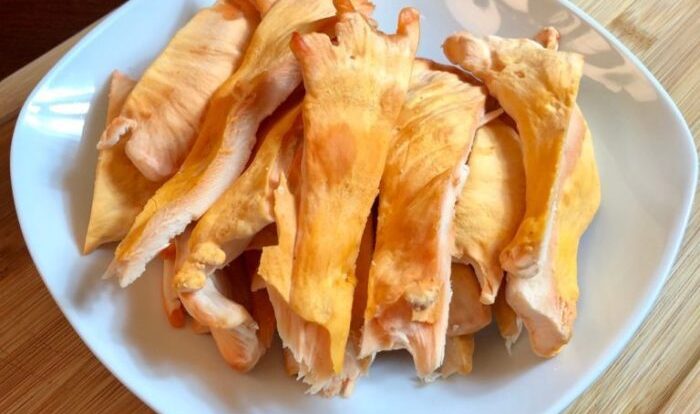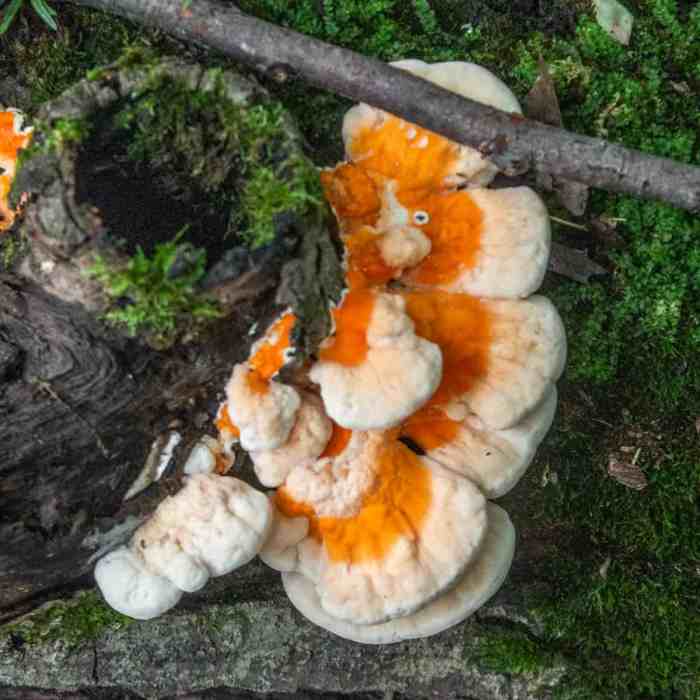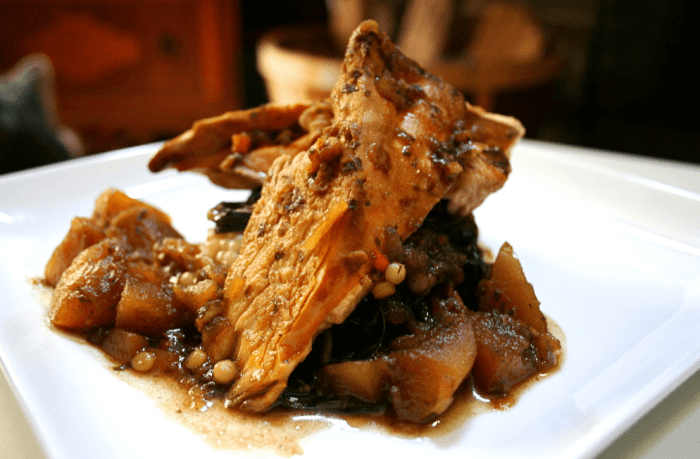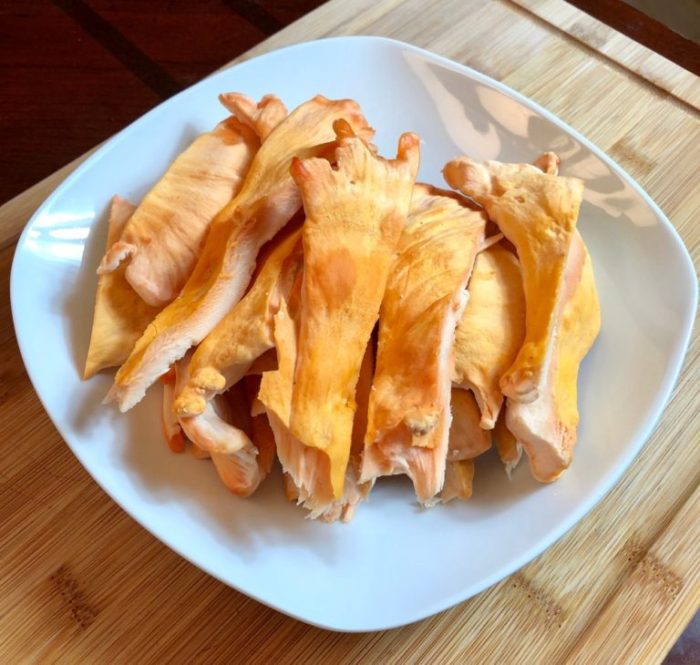
Chicken of the woods recipe, a culinary delight that tantalizes taste buds, is more than just a delicious meal. Its nutritional value and health benefits make it a hidden gem in the world of fungi. Dive into this comprehensive guide to discover the culinary wonders of chicken of the woods and its remarkable properties.
From sautéing to grilling, roasting to frying, chicken of the woods offers a versatile canvas for culinary creativity. Its meaty texture and mild flavor make it a perfect substitute for chicken, offering a unique twist to your favorite dishes. Let’s explore the diverse culinary applications and tantalizing recipes that showcase the versatility of this extraordinary mushroom.
Overview of Chicken of the Woods
Chicken of the Woods ( Laetiporus sulphureus) is a polypore mushroom known for its bright orange to yellow coloration and unique chicken-like flavor and texture. It is a large, fleshy mushroom with a fan-shaped or shelf-like growth form, often growing in clusters on the sides of trees or logs.
Chicken of the Woods has a firm, meaty texture and a mild, savory flavor that resembles chicken or seafood. It is a popular edible mushroom prized for its versatility in cooking. There are several varieties of Chicken of the Woods, including the most common sulfur shelf ( Laetiporus sulphureus), the pink oyster ( Laetiporus cincinnatus), and the blue oyster ( Laetiporus huroniensis). Each variety has slightly different characteristics in terms of appearance and flavor.
Nutritional Value and Health Benefits
Chicken of the Woods is a nutritious mushroom rich in dietary fiber, protein, and vitamins. It is a good source of antioxidants, including ergothioneine and glutathione, which have been linked to various health benefits, such as reducing inflammation and protecting against oxidative stress.
Culinary Applications of Chicken of the Woods

Chicken of the Woods is a versatile mushroom with a wide range of culinary applications. It can be sautéed, grilled, roasted, or fried, and pairs well with a variety of ingredients and seasonings.
Sautéing
Sautéing Chicken of the Woods is a quick and easy way to cook it. Simply heat some oil in a skillet over medium heat and add the mushrooms. Cook until they are browned and tender, about 5-7 minutes. Season with salt, pepper, and any other desired spices.
Grilling
Grilling Chicken of the Woods gives it a smoky flavor. Preheat your grill to medium-high heat and brush the mushrooms with olive oil. Grill for 5-7 minutes per side, or until they are cooked through.
Roasting
Roasting Chicken of the Woods is a great way to bring out its earthy flavor. Preheat your oven to 400 degrees Fahrenheit and toss the mushrooms with olive oil, salt, and pepper. Roast for 20-25 minutes, or until they are tender and slightly browned.
Frying
Frying Chicken of the Woods gives it a crispy exterior and a tender interior. Heat some oil in a skillet over medium heat and add the mushrooms. Fry for 3-5 minutes per side, or until they are golden brown and cooked through.
Pairing with Other Ingredients and Seasonings
Chicken of the Woods pairs well with a variety of ingredients and seasonings. Some popular pairings include:
- Garlic and thyme
- Lemon and rosemary
- Bacon and onions
- Parmesan cheese
- Truffle oil
Foraging and Identification

Chicken of the Woods is a popular edible mushroom found in various regions. Understanding the best time and places to forage for it, as well as its key identification characteristics, is crucial to ensure a successful and safe foraging experience.
When and Where to Forage
- Chicken of the Woods typically appears in late summer and fall.
- It favors moist, hardwood forests, especially near the base of oak, maple, or beech trees.
- Look for it on fallen logs, stumps, or living trees.
Identification
- Shape and Size:Chicken of the Woods forms shelf-like or bracket-shaped clusters with a bright orange or yellow upper surface.
- Texture:It has a firm, meaty texture and a slightly spongy interior.
- Pores:The underside of the mushroom features small, white to cream-colored pores.
- Spore Print:The spore print is white.
Potential Lookalikes
Several other mushrooms resemble Chicken of the Woods, but some key differences help distinguish them:
- False Chicken of the Woods (Laetiporus sulphureus):Similar in appearance but has a yellow underside and a bitter taste.
- Polyporus squamosus:Also known as Dryad’s Saddle, it has a scaly upper surface and a more fibrous texture.
- Ganoderma tsugae:Has a reddish-brown upper surface and a bitter taste.
When foraging for Chicken of the Woods, it’s essential to carefully observe its characteristics and consult with experienced foragers or field guides to avoid misidentification.
Health Considerations and Safety: Chicken Of The Woods Recipe

Chicken of the Woods is generally considered safe to consume when properly identified and cooked. However, it’s important to note that, like many other wild mushrooms, it can cause adverse effects in certain individuals.
Consuming raw or undercooked Chicken of the Woods can lead to gastrointestinal issues such as nausea, vomiting, and diarrhea. These symptoms are typically transient and resolve within a few hours. Additionally, some people may experience allergic reactions to the mushroom, ranging from mild skin irritation to more severe respiratory distress.
Proper Identification and Cooking
To avoid any potential risks, it’s crucial to properly identify Chicken of the Woods before consuming it. Consult with experienced foragers or use reliable field guides to ensure accurate identification. Furthermore, cooking the mushroom thoroughly by sautéing, grilling, or roasting helps to eliminate any potential toxins and reduce the risk of adverse effects.
Medicinal Properties, Chicken of the woods recipe
Chicken of the Woods possesses several medicinal properties and potential health benefits. It contains antioxidants, anti-inflammatory compounds, and antimicrobial substances. Some studies suggest that it may have antitumor and immune-boosting effects, although further research is needed to confirm these claims.
Sustainability and Conservation
As with all wild mushrooms, sustainable foraging practices are crucial for the preservation of Chicken of the Woods. Over-harvesting and habitat destruction can significantly impact the mushroom’s population and its delicate ecosystem.
Responsible Foraging Practices
To ensure the sustainability of Chicken of the Woods, consider the following responsible foraging practices:
- Harvest only mature mushrooms:Allow young mushrooms to grow and reproduce, ensuring future populations.
- Avoid over-harvesting:Take only what you need, leaving plenty for others and the ecosystem.
- Use a sharp knife:Cleanly cut mushrooms at the base, minimizing damage to the mycelium.
- Leave the area undisturbed:Avoid trampling or disturbing the surrounding habitat.
- Educate yourself:Learn to identify Chicken of the Woods accurately to prevent accidental harvesting of look-alikes.
Habitat Conservation
Protecting the habitats where Chicken of the Woods grows is essential for its long-term survival. Consider the following conservation measures:
- Preserve forests:Chicken of the Woods relies on decaying wood for its growth. Protect old-growth forests and promote sustainable forestry practices.
- Reduce pollution:Air and water pollution can harm the mushroom’s mycelium and fruiting bodies.
- Support organizations:Join conservation groups dedicated to protecting mushroom habitats and promoting sustainable foraging.
By adhering to responsible foraging practices and supporting habitat conservation efforts, we can help ensure the long-term availability of Chicken of the Woods and its ecological benefits.
Final Review

Embarking on a foraging adventure for chicken of the woods not only enriches your culinary skills but also fosters a deeper connection with nature. Remember to forage responsibly, respecting the delicate balance of the ecosystem. By understanding the key characteristics and potential lookalikes, you can confidently identify and harvest this culinary treasure.
So, grab your basket and venture into the woods, where the hunt for chicken of the woods promises both gastronomic delights and a profound appreciation for the wonders of nature.
Popular Questions
Is chicken of the woods safe to eat?
Yes, chicken of the woods is safe to eat when properly identified and cooked. It’s important to note that some people may experience allergic reactions, so it’s always advisable to introduce new mushrooms gradually into your diet.
What are the health benefits of chicken of the woods?
Chicken of the woods is a good source of dietary fiber, protein, and antioxidants. It also contains anti-inflammatory and antimicrobial properties, making it a potential ally in boosting immunity and overall well-being.
How can I identify chicken of the woods?
Chicken of the woods typically grows in clusters on the sides of trees, especially oaks. It has a bright orange to yellow color and a slightly hairy texture. The underside features pores instead of gills, and the flesh is white and firm.





